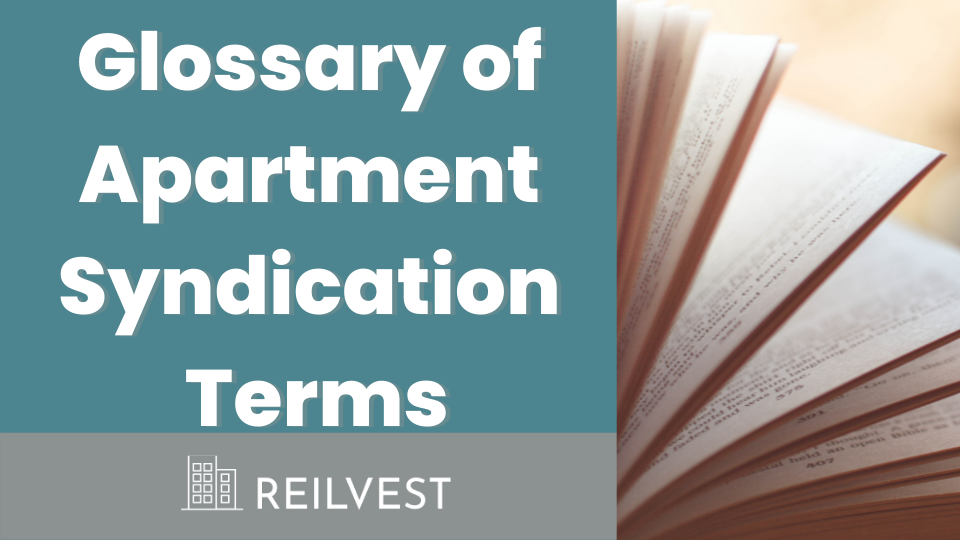A glossary of terms and definitions, listed in alphabetical order, used in apartment syndications for aspiring real estate syndicators and passive investors to help understand the industry terminology.
A
Absorption Rate: The rate at which available rentable units are leased in a specific real estate market or submarket within a defined period of time.
Accredited Investor: An individual who can invest in apartment syndications or other investment offerings by meeting one of the requirements regarding income or net worth. Currently, to be considered an accredited investor, a person must have an annual income exceeding $200,000 ($300,000 for joint income) for the last two years with the expectation of earning the same or a higher income in the current year or a net worth exceeding $1 million either individually or jointly with a spouse.
Acquisition Fee: The upfront fee paid by investors (limited partners) to the syndicator (sponsor or general partner) for finding, evaluating, financing, closing, and managing the investment.
Active Investing: Someone who invests in real estate by actively working to find, fund, fix, rent, manage, and/or sell the property.
Amortization: The paying off of a mortgage loan by making fixed payments of principal and interest over a specific time period.
Apartment Syndication: The pooling of money from numerous investors that will be used to buy an apartment building and execute a strategic business plan. In an apartment syndication, the syndicators and investors share risks and returns. The syndicators are active investors also know as the general partners while the investors are passive investors or limited partners.
Appraisal: An official report created by a certified appraiser that determines the market value of a property. The value is based on cost, nearby comparable sales within the market or submarket, and the income approach.
Appreciation: An increase in the value of an asset either by adding value to the asset through renovations and/or operational improvements or naturally over time when the asset is worth more due to market conditions. adding value to the apartment through renovations and/or operational improvements.
Asset Management Fee: An ongoing annual fee paid to the syndicators for oversight of the property and property operations.
B
Bad Debt: Uncollected rents or uncollected money owed by a tenant after move-out.
Breakeven Occupancy: The rate of occupancy needed to cover all of the expenses of a property
Bridge Loan: A short-term mortgage loan typically 6 months to three years, used until a borrower secures permanent financing. Bridge loans generally have higher interest rates and are usually interest only. This kind of financing option is typically used to reposition an apartment community that doesn’t qualify for permanent financing.
C
Capital Expenditures (CapEx): A payment of any type of expense that a company capitalizes, or shows on its balance sheet as an investment, rather than on its income statement as an expenditure because of its useful life, like replacing a roof.
Capitalization Rate (Cap Rate): A rate of return on the income a property is expected to generate; calculated by dividing the net operating income of the property by the current market value of a property.
Cash Flow: Subtract the operating expense and debt service from the income to get the revenue remaining after paying all expenses.
Cash-on-Cash Return: The rate of return based on the cash flow and the capital investment. Often referred to as CoC return, Cash-on-Cash Return is calculated by dividing the cash flow by the initial capital investment.
Closing Costs: The expenses, separate from the purchase price of the property, that buyers and sellers normally pay to complete a real estate transaction. These include origination fees, application fees, recording fees, attorney fees, underwriting fees, and due diligence fees.
Concessions: Credits given to offset rent, application fees, move-in fees and any other cost paid for by an incoming tenant. Concessions are typically given to attract tenants and get them to commit to signing a lease.
Cost Approach: A method of calculating a property’s value based on the cost to replace (or rebuild) the property from scratch. Typically referred to as the replacement approach.
D
Debt Service The annual mortgage amount (principal and interest) paid to the lender. The principal is the original amount borrowed and interest is the charge for borrowing the principal amount.
Debt Service Coverage Ratio (DSCR): The ratio between cash flow available to pay the debt obligation and debt service. Usually referred to as the DSCR, and is calculated by dividing the net operating income by the total debt service. A DSCR of 1.0 means that there is enough net operating income to cover 100% of the debt service. Thus, most lenders will require a DSCR is 1.25 or higher because A property with a DSCR too close to 1.0 is a riskier investment, and a minor decline in revenue or minor increase in expenses would result in the inability to service the debt.
Depreciation: A decrease or loss in value of an asset due to time, wear & tear, age or other cause
Distressed Property: A non-stabilized property that has an economic occupancy rate that is below 85% and likely much lower due to poor operations, tenant problems, outdated interiors, exteriors or amenities, mismanagement and/or deferred maintenance.
Distributions: The limited partner’s portion of the profits, which are sent on a monthly, quarterly or annual basis, at refinancing and/or at sale
Due Diligence: The process of confirming that a property is as represented by the seller and is not subject to environmental or other problems. For apartment syndications, the general partner will perform due diligence to confirm their underwriting assumptions and business plan.
E
Earnest Money Deposit: A payment (Deposit) by the buyers that is a portion of the purchase price to indicate to the seller the intention and ability to carry out the purchase. Usually referred to as EMD
Economic Occupancy Rate: The rate of paying tenants based on the total possible revenue and the actual revenue collected. To calculate economic occupancy, divide the actual revenue collected by the gross potential income.
Effective Gross Income (EGI): The true positive cash flow. Also referred to as EGI. To calculate EGI, subtract the revenue lost due to economic and physical vacancy, loss-to-lease, concessions, and bad debt from the gross potential income.
Equity Investment: The upfront costs for purchasing a property. In a syndication, these costs include the down payment, closing costs, financing fees, due diligence fees, operating reserves, and acquisition fees paid to the sponsors (syndicators) for putting the deal together.
Equity Multiple (EM): The rate of return based on the total amount invested and the total net profit. To calculate the EM divide the sum of the total net profit (all cash flow distributions and the proceeds from the sales) and the equity investment by the equity investment.
Exit Strategy: The deal sponsor’s strategic plan of action for selling or refinancing the property.
F
Financing Fees: The one-time, upfront fees charged by the lender for providing the debt service. Also referred to as finance charges or origination costs.
G
General Partner (GP): Usually a managing partner who is active in the day-to-day operations of the business. In a syndication, the general partner is also referred to as the sponsor or syndicator and is responsible for managing the entire project, from finding the deal, arranging financing, and executing the business plan.
Gross Potential Income: The potential amount of revenue if the asset was 100% leased year-round at market rental rates plus any other income.
Gross Potential Rent (GPR): The potential amount of revenue if the asset was 100% leased year-round at market rental rates. Typically referred to as GPR.
Gross Rent Multiplier (GRM): The number of years it would take for a property to pay for itself based on the gross potential rent. To calculate the GRM, divide the purchase price by the annual gross potential rent.
Guaranty Fee: A fee paid to a loan guarantor at closing for signing for and guaranteeing the loan.
H
Holding Period: The amount of time the syndicator plans on holding on to the investment.
I
Income Approach: A way to calculate an apartment’s value based on the capitalization rate and the net operating income. The calculation is written as:
Property Value = Net Operating Income ÷ Capitalization Rate
Interest Rate: The amount charged by a lender to a borrower for the use of their funds.
Interest-Only Payment: A type of monthly mortgage payment where the lender only requires the borrower to pay the interest only on the principal. This kind of repayment is usually associated with a short-term or bridge loan.
Internal Rate of Return (IRR): IRR is a metric used in financial analysis to estimate the profitability of potential investments. It incorporates the time value of money and is commonly used to compare investment options against each other.
J
K
L
Lease: A formal legal contract between a landlord and a tenant for living in an apartment for a specified time and at a specified price with specified terms.
Letter of Intent (LOI): A non-binding agreement created by a buyer outlining their intent to purchase property and under specific terms.
Limited Partner (LP): Usually referred to as the LP, a limited partner is one whose liability is limited to the extent of their share of ownership. In syndications, the LP is a passive investor who provides capital as a portion of the equity investment
London Interbank Offered Rate (LIBOR): A benchmark rate that some of the world’s leading banks charge each other for short-term loans. Also referred to as LIBOR. The LIBOR serves as the first step to calculating interest rates on various loans, including commercial loans, throughout the world.
Loan-to-Cost Ratio (LTC): The ratio between the value of the total project costs (loan amount + capital expenditure costs) divided by the asset’s appraised value.
Loan-to-Value Ratio (LTV): The ratio between the value of the loan amount divided by the assets appraised value. Put plainly, what percentage of the asset’s value the bank will lend on.
Loss-to-Lease (LtL): The difference between a property or unit’s market rental rate and the actual rent per the lease.
M
Market Rent: Based on other rented units in the area, market rent is the rent amount a willing landlord will expect to receive and a willing tenant will expect to pay for tenancy. In order to calculate market rent, a landlord must perform a rental comparable analysis
Metropolitan Statistical Area (MSA): A geographical region with a relatively high population density at its core and close economic ties throughout the area and usually. A typical metropolitan area is centered on a single large city that has substantial influence over the region. MSAs are determined by the United States Office of Management and Budget (OMB).
Model Unit: An apartment unit used as a marketing tool to show potential tenants what the actual unit will look like once occupied.
Mortgage: A legal contract by which an asset is pledged as security for repayment of a loan until the debt is repaid in full. A mortgage guarantees the loan will be repaid or the assets will be seized if the loan is not paid
N
Net Operating Income (NOI): All the revenue generated by the property minus all the operating expenses (not including debt service. Typically referred to as the NOI.
O
Operating Account Funding: A reserves fund, over and above the purchase price of an apartment, to cover things like unexpected vacancy, lump sum insurance or tax payments, or unforeseen capital expenditures. The operating account funding is typically created by raising extra capital from the limited partners
Operating Agreement: A legal document that outlays the responsibilities and ownership percentages for the general and limited partners in syndication.
Operating Expenses: The costs associated with running (operating) and maintaining the property. For syndicators, the operating expense is usually broken into the following categories: payroll, maintenance, and repairs, contract services, make-ready costs, advertising/marketing, administrative, utilities, management fees, taxes, insurance, and operating reserves
P
Passive Investor: An investor who invests capital into apartment syndication that is managed in its entirety by a general partner
Permanent Agency Loan: A long-term mortgage loan secured by Fannie Mae or Freddie Mac. Typical loan terms lengths are 3-12 or more years amortized over up to 30 years
Physical Occupancy Rate: The rate of occupied units. To calculate the physical occupancy rate, divide the total number of occupied units by the total number of units at the property.
Preferred Return: The minimum return that limited partners are offered and receive first before the general partners receive payment. This method of structuring returns is used to attract investors to the deal.
Prepayment Penalty: A clause in a mortgage contract that requires a penalty to be assessed if the mortgage is paid down or paid off earlier than outlined in the loan terms.
Price Per Unit: The cost of a multi-unit property divided by the number of units
Private Placement Memorandum (PPM): A legal document that outlines the terms and risk factors involved with an investment. Usually referred to as the PPM and drafted by an attorney, it contains four main sections: the introductions (a brief summary of the offering), basic disclosures (general partner information, asset description, and risk factors), the legal agreement, and the subscription agreement.
Pro-forma: The projected budget with itemized line items for the revenue and expenses for the next 12 months sometimes including projections as far as five years out.
Profit and Loss Statement: A financial accounting statement with detailed information about the revenue and expenses of a property for a given year. Usually referred to as a P&L
Profit and Loss Statement (T-12): Also referred to as a trailing 12-month profit and loss statement or a profit and loss statement specifically for the last 12 months.
Property and Neighborhood Classes: A ranking system of A, B, C, or D assigned to a property or a neighborhood based on a variety of factors. For property classes, these factors include the date of construction, the condition of the property, and the amenities offered. For neighborhood classes, these factors include demographics, median income, median home values, crime rates, and school district rankings.
Property Management Fee: An ongoing monthly fee paid to the property management company for managing the day-to-day operations of the property, including rent collection, leasing, maintenance, and repairs.
Q
R
Ration Utility Billing System (RUBS): A system where a tenant’s utilities are billed back to tenants by calculating their utility usage based on occupancy, unit square footage, or a combination of both.
Recourse: The right of a lender to go after a borrower’s personal assets above and beyond the collateral (in property) if the borrower defaults on the loan.
Refinance: Replacing an existing loan with another loan that has different (often better) terms.
Refinancing Fee: A fee paid to the syndicator (general partner) for the work required to refinance a commercial loan.
Rent Comparable Analysis: An analysis of rental rates of similar properties in close proximity to the subject property to determine the market rents of the units at the subject property. usually referred to as “rental comps”.
Rent Premium: The increase in rent demanded after performing renovations to the interior and/or exterior of a rental unit or property
Rent Roll: A financial document or spreadsheet containing detailed information on each of the units of a commercial property, including the unit number, unit type, square footage, tenant name, market rent, actual rent, deposit amount, move-in date, lease-start, and lease-end dates, and the tenant balance.
S
Sales Comparison Approach: A method of calculating a property’s value based on similar properties recently sold in the area.
Sales Proceeds: the profit collected at the sale of a property
Sophisticated Investor: An investor who has ample investing experience and knowledge to weigh the risks and merits of a potential investment opportunity.
Subject Property: The property that a syndicator intends to purchase.
Submarket: A geographic subdivision of a market, i.e., a small town in a bigger city.
Subscription Agreement: A legal document that is a promise by the LLC that owns the property to sell a specific number of shares to a limited partner at a specified price and a promise by the limited partner to pay that price for shares in the investment property.
T
U
Underwriting: The process of financially evaluating a potential investment property to determine the projected returns and an offer price that ensures profitability.
V
Vacancy Loss: The amount of rental income lost due to vacant units
Vacancy Rate: The percentage rate of unoccupied units. To calculate the vacancy rate, divide the total number of vacant units by the total number of units at the property.
Value-Add Property: A stabilized property that has an economic occupancy above 85% and has the opportunity to be improved by adding value, like improvements to the operations of the property (reducing expenses and increasing income) and/or improvements to the physical property through exterior and interior renovations.
W
X
Y
Yield Maintenance: A penalty paid by the borrower to the lender on a loan if the principal is paid off early. Lenders charge borrowers yield maintenance to ensure they will not lose the projected interest income from the loan.








